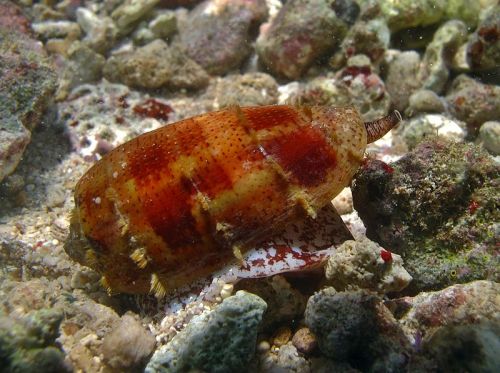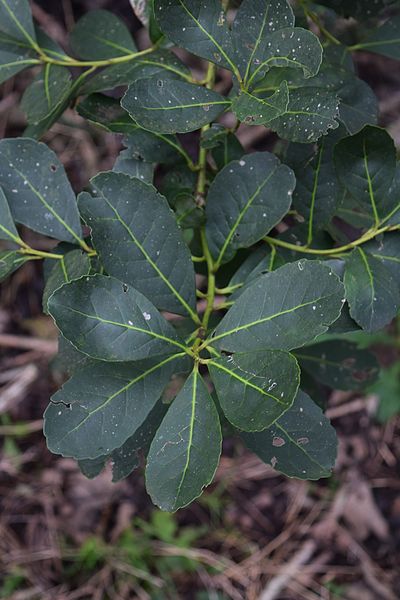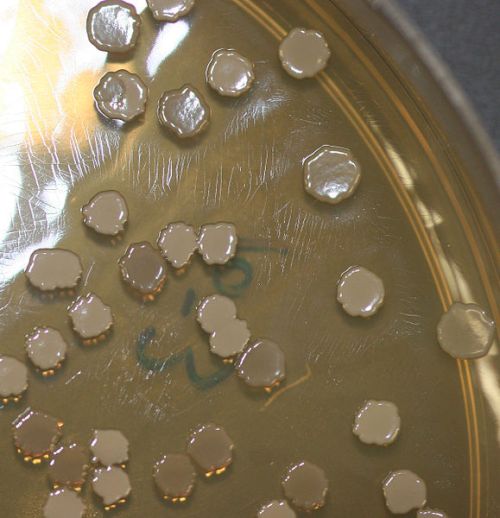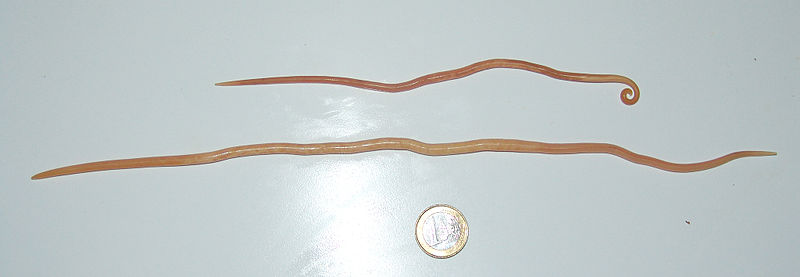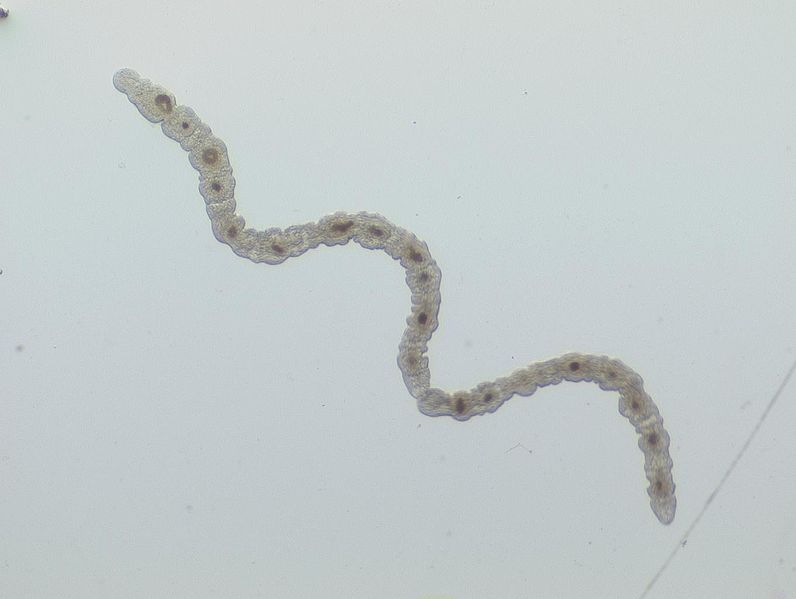by Piter Kehoma Boll
We are approaching the end of the description of Linnaeus’ classification of Plants (see parts 1, 2, 3, 4, 5 and 6). Today I’ll show two more classes, the last two of plants with mainly hermaphrodite flowers.
19. Syngenesia (“same generation”)
“Husbands composed of a generative compact”, i.e., the stamens are united, forming a cylinder.
19.1 Syngenesia Polygamia Aequalis (“same generation, many equal marriages”), compound flowers formed by several small compact flowers, all having stamens and pistils: Scolymus (golden thistles), Cichorium (chicories), Catananche (cupid’s darts), Hypochaeris (cat’s ears), Andryala (andryalas), Tragopogon (goatsbeards), Picris (oxtongues), Leontodon (hawkbits and dandelions), Sonchus (sow thistles), Scorzonera (salsifies), Crepis (hawksbeards), Chondrilla (skeletonweeds), Prenanthes (rattlesnake roots), Lactuca (lettuces), Hieracium (hawkweeds), Lapsana (nippleworts), Hyoseris (hyoserises), Elephantopus (elephant’s foot), Atractylis (spindle thistles), Carlina (carline thistles), Cnicus (thistles), Arctium (burdocks), Carthamus (distaff thistles), Cynara (alcachofras), Carduus (more thistles), Onopordum (cotton thistles), Serratula (plumeless saw-worts), Echinops (globe thistles), Ageratum (whiteweeds), Cacalia (false plantains), Chrysocoma (goldenhairs), Eupatorium (thoroughworts), Santolina (cotton lavenders), Bidens (beggarticks), Staehelina (staehelinas), Stoebe (stoebes), Tarchonanthus (camphor bush).
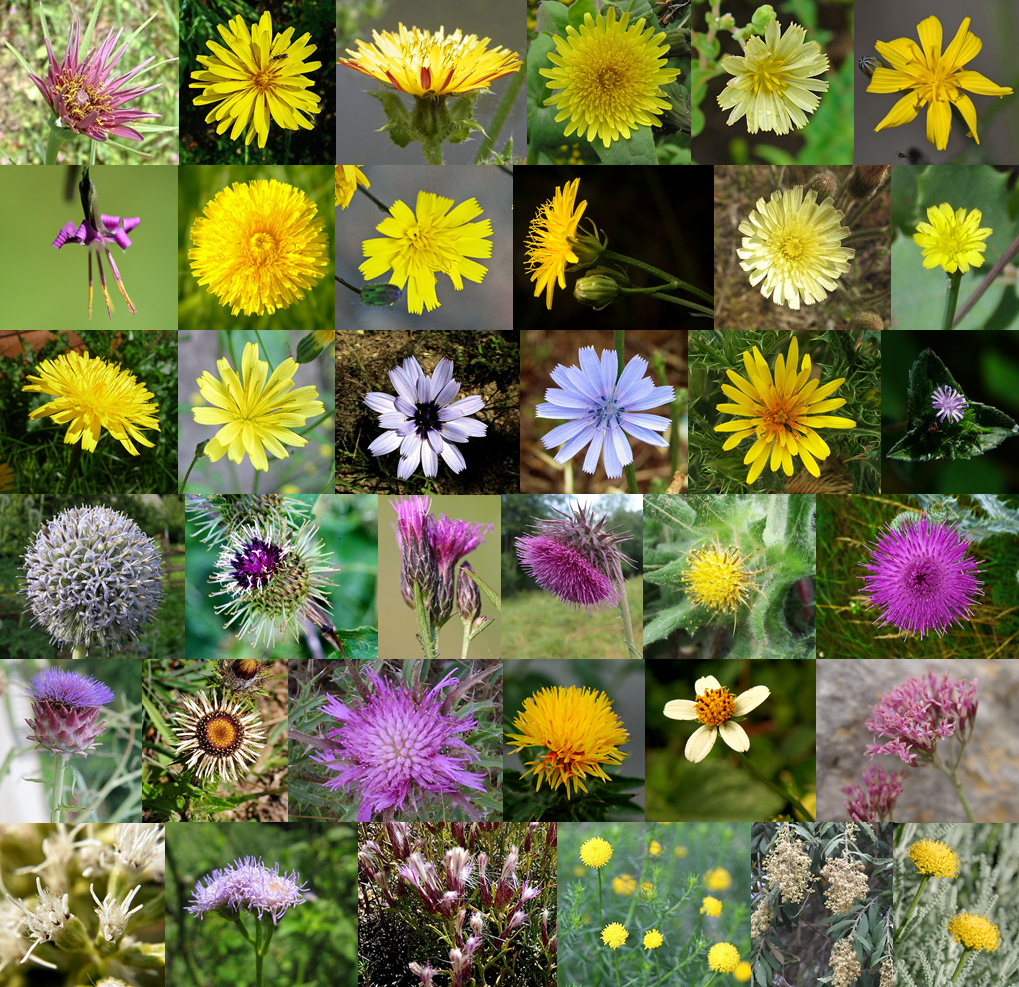
The diverse order Syngenesia Polygamia Aequalis included (from left to right, top to bottom) the common goatsbeard (Tragopogon porrifolius), black salsify (Scorzonera hispanica), bristly oxtongue (Picris echioides, now Helminthotheca echioides), common sowthistle (Sonchus oleraceus), garden lettuce (Lactuca sativa), rush skeletonweed (Chondrilla juncea), common rattlesnake root (Prenanthes purpurea), common dandelion (Leontodon taraxacum, now Taraxacum officinale), rattlesnake hawkweed (Hieracium venosum), beaked hawksbeard (Crepis vesicaria), common andryala (Andryala integrifolia), smooth hyoseris (Hyoseris scabra), common cat’s ear (Hypochaeris radicata), common nipplewort (Lapsana communis), blue cupid’s dart (Catananche caerulea), common chicory (Cichorium intybus), Spanish golden thistle (Scolimus hispanicus), smooth elephant’s foot (Elephantopus scaber), great globe thistle (Echinops sphaerocephalus), great burdock (Arctium lappa), dyer’s plumeless saw-wort (Serratula tinctoria), musk thistle (Carduus nutans), holy thistle (Cnicus benedictus, now Centaurea benedicta), common cotton thistle (Onopordum acanthium), globe artichoke (Cynara scolymus), common carline thistle (Carlina vulgaris), common spindle thistle (Atractylus huilis), safflower (Carthamus tinctorius), common beggartick (Bidens pilosa), Alpine plantain (Cacalia alpina, now Adenostyles alpina), tall thoroughwort (Eupatorium altissimum), common whiteweed (Ageratum conyzoides), dubious staehelina (Staehelina dubia), common goldenhair (Chrysocoma coma-aurea), camphor bush (Tarchonanthus camphoratus), and common cotton lavender (Santolina chamaecyparissus). Credits to Stephen Lea (goatsbeard), H. Zell (salsify, lettuce, cotton thistle), Tony Wills (sow thistle), Radio Toreng (skeletonweed), Jane Shelby Richardson (hawkweed), Manfred Moitzi (hawksbeard), Pablo Alberto Salguero Quilles (andryala), smooth hyoseris (Hyoseris scabra), Javier Martin (hyoseris, spindle thistle), Phil Sellens (nipplewort), Isidre Blanc (cupid’s dart, staehelina), Joaquim Alves Gaspar (chicory, golden thistle, globe artichoke), Dinesh Valke (elephant’s foot), Enrico Blasutto (burdock), Kristian Peters (plumeless saw-wort), Bernd Haynold (musk thistle), Philipp Weigell (carline thistle), Vishesh Bajpai (beggartick),Benjammin Zwittnig (Alpine plantain), Frank Mayfield (thoroughwort), Peter A. Mansfeld (goldenhair), Paul Venter (camphor bush), Marie-Lan Nguyen (cotton lavender), and Wikimedia users AnemoneProjectors (oxtongue, cat’s ear), Calimo (rattlesnake root), Kropsoq (dandelion), Epp (globe thistle), 00temari (holy thistle), Pseudoanas (safflower) and Leoadec (whiteweed).*
19.2 Syngenesia Polygamia Superflua (“same generation, many remaining marriages”), compound flowers formed by several small compact flowers forming a central disk of hermaphrodite flowers surrounded by a ring of feminine flowers. Both hermaphrodite and feminine flowers are fertile and produce seeds: Tanacetum (tansies), Artemisia (artemisias), Gnaphalium (cudweeds), Xeranthemum (dry everlastings), Carpesium (carpesiums), Baccharis (baccharises), Conyza (horseweeds), Erigeron (fleabanes), Tussilago (coltsfoots), Senecio (ragworts and groundsels), Aster (asters), Solidago (goldenrods), Inula (inulas), Arnica (arnicas), Doronicum (leopard’s banes), Helenium (sneezeweeds), Bellis (daisies), Tagetes (marigolds), Zinnia (zinnias), Pectis (cinchweeds), Chrysanthemum (chrysanthemums and daisies), Matricaria (chamomiles), Cotula (water buttons), Anacyclus (anacycles), Anthemis (false chamomiles), Achillea (yarrows), Tridax (coatbuttons), Amellus (amelluses), Sigesbeckia (St. Paul’s worts), Verbesina (crownbeards), Tetragonotheca (neverays), Buphthalmum (ox-eyes).
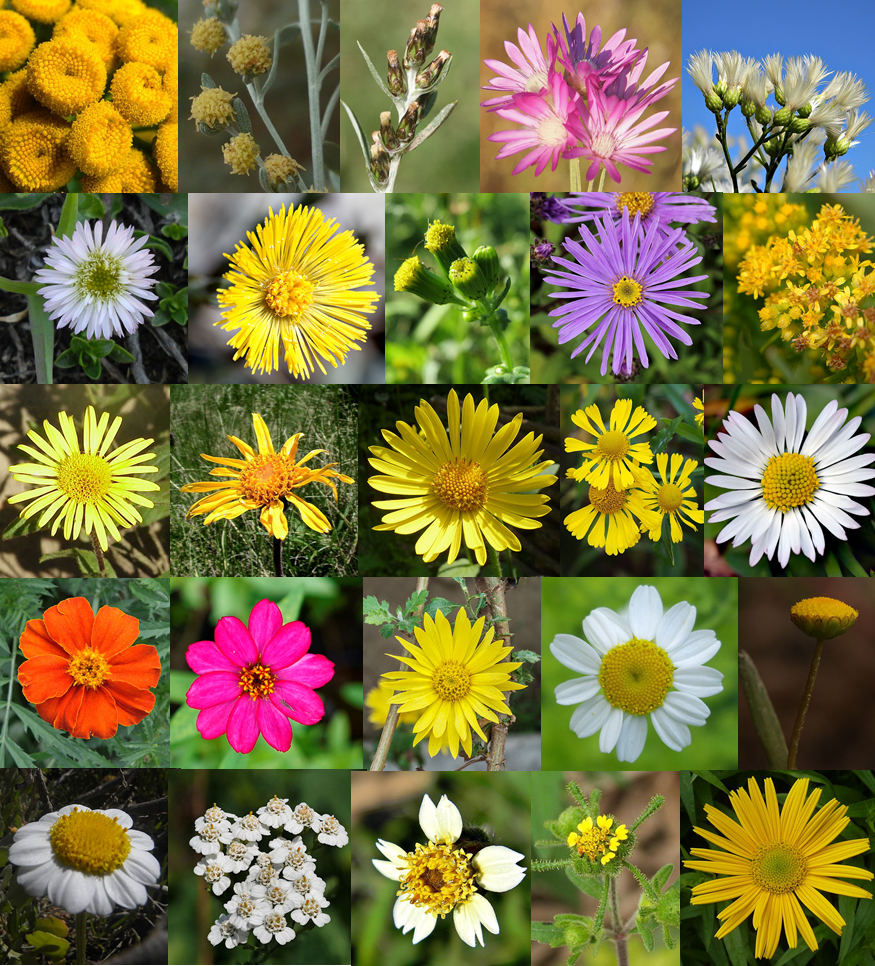
Linnaeus put this species in the order Syngenesia Polygamia Superflua (from left to right, top to bottom): common tansy (Tanacetum vulgare), wormwood (Artemisia absinthium), heath cudweed (Gnaphalium sylvaticum), annual dry everlasting (Xeranthemum anuum), saltbush (Baccharis halimifolia), one-flower fleabane (Erigeron uniflorus), common coltsfoot (Tussilago farfara), common groundsel (Senecio vulgaris), Italian aster (Aster amellus), seaside goldenrod (Solidago sempervirens), hairy inula (Inula hirta), mountain arnica (Arnica montana), common leopard’s bane (Doronicum pardalianches), common sneezeweed (Helenium autumnale), common daisy (Bellis perennis), French marigold (Tagetes patula), Peruvian zinnia (Zinnia peruviana), Indian chrysanthemum (Chrysanthemum indicum), common chamomile (Matricaria chamomilla), buttonweed (Cotula coronopifolia), common anacycle (Anacyclus valentinus), sea false-chamomile (Anthemis maritima), common yarrow (Achillea millefolium), coatbuttons (Tridax procumbens), eastern St. Paul’s wort (Siegesbeckia orientalis), ox-eye (Buphthalmum salicifolium>). Credits to Muriel Bendel (tansy), Hermann Schachner (cudweed), Musa Geçit (dry everlasting), Bob Peterson (saltbush, coatbuttons), André Karwath (coltsfoot, daisy), C T Johansson (aster), Sam Fraser-Smith (goldenrod), Kurt Stüber (inula), Isidre Blanc (arnica), Agnieszka Kwiecien (sneezeweed), Lynda Poulter (chamomile), Walter Siegmund (buttonweed), Denis Barthel (false-chamomile), Petar Milošević (yarrow), and Wikimedia users N-Baudet (wormwood), Ghislain118 (fleabane), AnRo0002 (groundsel), Jamain (leopard’s bane, ox-eye), Rasbak (marigold), Vengolis (zinnia), Joydeep (chrysanthemum), Philmarin (anacycle) and Elouanne (St. Paul’s wort).
19.3 Syngenesia Polygamia Frustranea (“same generation, many marriages in vain”), compound flowers formed by several small compact flowers forming a central disk of hermaphrodite flowers surrounded by a ring of neutral flowers, without sexual organs, therefore only the flowers of the disk are fertile and produce seeds: Helianthus (sunflowers), Rudbeckia (black-eyed-susans), Coreopsis (coreopsises), Gorteria (gorterias), Centaurea (knapweeds), Gundelia (gundelia).

The order Syngenesia Polygamia Frustranea included (from left to right) the common sunflower (Helianthus annuus), common black-eyed susan (Rudbeckia hirta), lance-leaved coreopsis (Coreopsis lanceolata), bachelor’s button (Centaurea montana), gundelia (Gundelia tournefortii). Credits to Frank Mayfield (black-eyed susan), Jean-Pol Grandmont (bachelor’s button), Gundelia (gundelia) and Wikimedia users i_am_jim (sunflower) and KENPEI (coreopsis).*
19.4 Syngenesia Polygamia Necessaria (“same generation, many unavoidable marriages”), compound flowers formed by several small compact flowers forming a central disk of hermaphrodite flowers, but whose feminine part is sterile, surrounded by a ring of fertile feminine flowers, therefore only the flowers of the ring produce seeds: Milleria (millerias), Silphium (rosinweeds), Chrysogonum (golden knees), Melampodium (blackfoots), Calendula (pot marigolds), Arctotis (bear’s ears), Osteospermum (daisybushes), Othonna (othonnas), Polymnia (leafcups), Eriocephalus (snow bushes), Filago (cudweeds), Micropus (cotton seeds), Sphaeranthus (ballflowers).
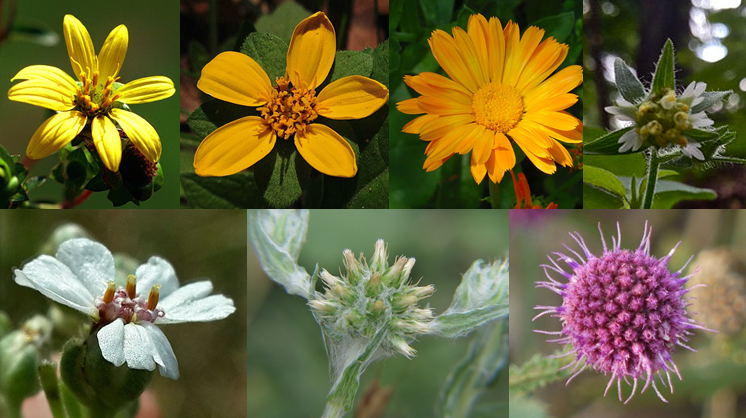
These 7 species were included by Linnaeus in the order Syngenesia Polygamia Necessaria (from left to right, top to bottom): starry rosinweed (Silphium asteriscus), common golden knee (Chrysogonum virginianum), common pot-marigold (Calendula officinalis), whiteflower leafcup (Polymnia canadensis), Cape snow bush (Eriocephalus africanus), common cudweed (Filago germanica, now Filago vulgaris), Indian ballflower (Sphaeranthus indicus). Credits to James H. Miller (rosinweed), Fritz Flohr Reynolds (golden knee, leafcup), Wouter Hagens (pot marigold), Juanita Vilas Marchant (snow bush), Wim Rubers (cudweed), Dinnesh Valke (balflower).*
19.5 Syngenesia Monogamia (“same generation, one marriage”), stamens united forming a cylinder, but with single flowers, not forming inflorescences: Seriphium (seriphiums), Corymbium (plampers), Jasione (scabiouses), Lobelia (lobelias), Viola (violets and pansies), Impatiens (balsams).

The sheep’s scabious (Jasione montana, left), garden lobelia (Lobelia erinus, center left), common violet (Viola odorata, center right), and garden balsam (Impatiens balsamina, right) were part of the order Syngenesia Monogamia. Credits to André Karwath (lobelia), Bernard Dupont (violet) and Wikimedia users Darkone (scabious) and Joydeep (balsam).*
20. Gynandria (“female husband”)
“Husbands monstruously united to women”, i.e., flowers with stamens united to the pistils.
20.1 Gynandria Diandria (“female husband, two husbands”), two stamens united to the pistils: Orchis (orchids), Satyrium (satyre orchids), Ophrys (fly and bee orchids), Serapias (Serapis orchids), Limodorum (grass pinks), Arethusa (dragon’s mouth and snake’s mouths), Cypripedium (lady’s slippers orchids), Epidendrum (epiphytic orchids).
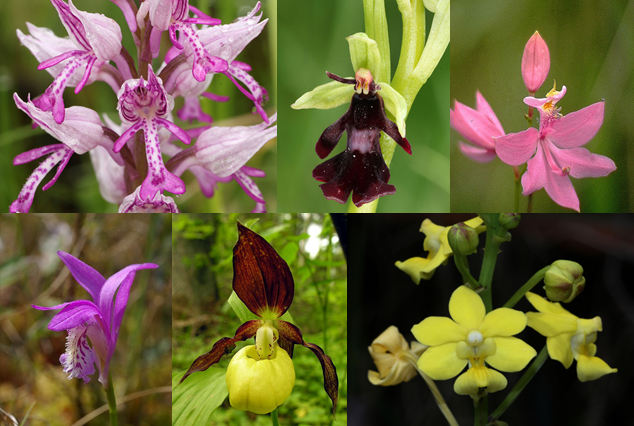
The order Gynandria Diandria included (from left to right, top to bottom) the military orchid (Orchis militaris), fly orchid (Ophrys insectifera), tuberous grass pink (Limodorum tuberosum, now Calopogon tuberosus), dragon’s mouth (Arethusa bulbosa), yellow lady’s slipper (Cypripedium calceolus), spathulate vanda (Epidendrum spathulatum, now Taprobanea spathulata). Credits to Holger Krisp (military orchid, fly orchid), Chris Meloche (dragon’s mouth), and Wikimedia users Algirdas (lady’s slipper) and CyberWikipedian (vanda).*
20.2 Gynandria Triandria (“female husband, three husbands”), three stamens united to the pistils: Sisyrinchium (blue-eyed grasses).
20.3 Gynandria Tetrandria (“female husband, four husbands”), four stamens united to the pistils: Nepenthes (pitcher plants).
20.4 Gynandria Pentandria (“female husband, five husbands”), five stamens united to the pistils: Ayenia (ayenias), Passiflora (passion flowers).
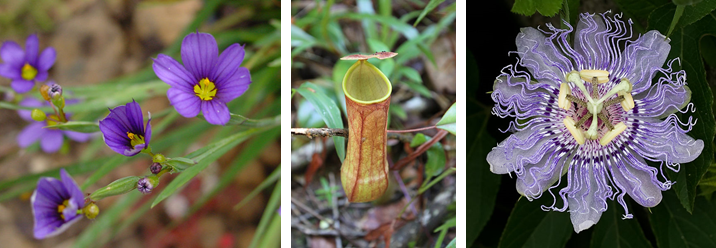
The common blue-eyed grass (Sisyrinchium bermudianum, left) was the only member of the order Gynandria Triandria. The distiller pitcher-plant (Nepenthes distillatoria, center) was the only member of the order Gynandria Tetrandria. The purple passion flower (Passiflora incarnata) was one of the members of the order Gynandria Pentandria. Credits to Wouter Hagens (blue-eyed grass), James & Jana Hans (pitcher-plant), Oliver P. Quillia (passion flower).*
20.5 Gynandria Hexandria (“female husband, six husbands”), six stamens united to the pistils: Aristolochia (pipevines), Pistia (water lettuce).
20.6 Gynandria Decandria (“female husband, ten husbands”), ten stamens united to the pistils: Helicteres (screw trees).

The order Gynandria Hexandria included the smearwort (Aristolochia rotunda, left) and the water lettuce (Pistia stratiotes, center). The order Gynandria Decandria included the Indian screw tree (Helicteres isora, right). Credits to J. M. Garg (screw tree) and Wikimedia users Hectonichus (smearwort) and Keisotyo (water lettuce).*
20.7 Gynandria Polyandria (“female husband, many husbands”), many stamens united to the pistils: Xylopia (xylopias), Grewia (crossberries), Arum (arums), Dracontium (arum yams), Calla (callas), Pothos (pothos), Zostera (eelgrasses).

The order Gynandria Polyandria included (from left to right) the crossberry (Grewia occidentalis), dragon arum (Arum dracunculus, now Dracunculus vulgaris), elephant-foot yam (Dracontium polyphyllum, now Amorphophallus paeoniifolius), wild calla (Calla palustris) and climbing pothos (Pothos scandens). Credits to P. Pickaert (arum), Kurt Stüber (calla), and Wikimedia users Consultaplantas (crossberry), Fotokannan (yam) and Vinayaraj (pothos).*
As you can see, the class Syngenesia is much more regular than the class Gynandria. Most species of Syngenesia are currently included in the family Asteraceae. Gynandria, on the other hand, includes a variety of unrelated plants, including orchids, arum plants and even passion flowers!
Here we finish all plants with hermaphroditic flowers. We only need two more posts and we will have seen the whole system of Linnaeus!
– – –
References:
Linnaeus, C. (1758) Systema Naturae per regna tria Naturae…
– – –
*
All images are licensed under a Creative Commons Attribution-ShareAlike 4.0 International License.
